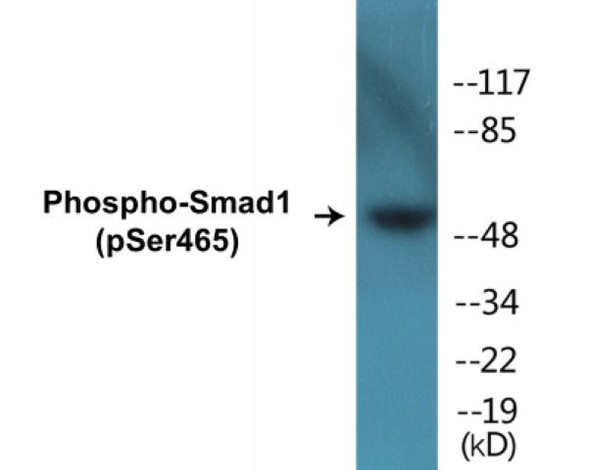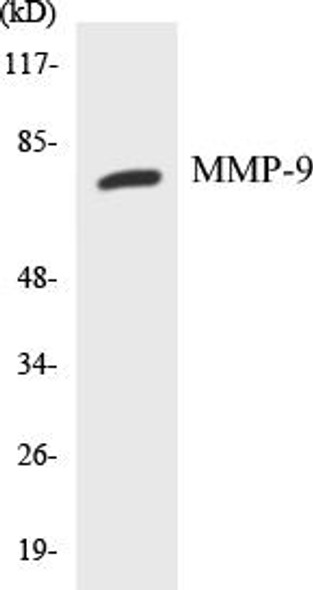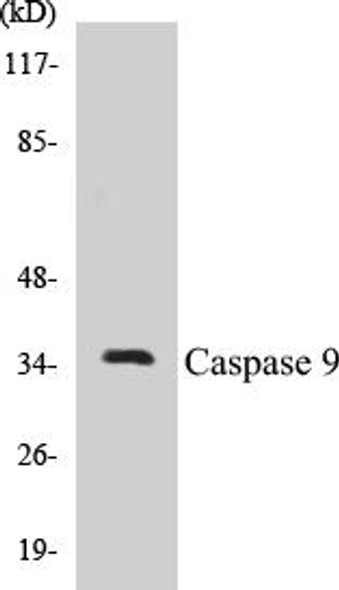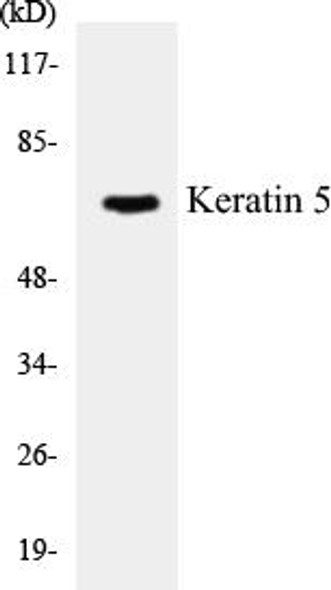Smad1/5/9 Colorimetric Cell-Based ELISA
- SKU:
- CBCAB00385
- Product Type:
- ELISA Kit
- ELISA Type:
- Cell Based
- Research Area:
- Epigenetics and Nuclear Signaling
- Reactivity:
- Human
- Mouse
- Rat
- Detection Method:
- Colorimetric
Description
Smad1/5/9 Colorimetric Cell-Based ELISA
The SMAD1/5/9 Colorimetric Cell-Based ELISA Kit is a powerful tool designed for the detection and quantification of SMAD1, SMAD5, and SMAD9 proteins in cell lysates or tissue extracts. This kit offers high sensitivity and accuracy, providing researchers with reliable and reproducible results for a variety of experimental applications.SMAD proteins are key components in the TGF-β signaling pathway, playing critical roles in cell regulation, development, and disease progression. By measuring the levels of SMAD1, SMAD5, and SMAD9, researchers can gain valuable insights into the mechanisms underlying cell signaling, growth, and differentiation.
Whether studying molecular pathways, investigating disease mechanisms, or developing potential therapeutic interventions, the SMAD1/5/9 Colorimetric Cell-Based ELISA Kit offers a robust and efficient solution for researchers seeking to explore the functions and interactions of SMAD proteins in cellular processes. Trust in the accuracy and precision of this ELISA kit to enhance your research and advance scientific discovery.
| Product Name: | Smad1/5/9 Colorimetric Cell-Based ELISA |
| Product Code: | CBCAB00385 |
| ELISA Type: | Cell-Based |
| Target: | Smad1/5/9 |
| Reactivity: | Human, Mouse, Rat |
| Dynamic Range: | > 5000 Cells |
| Detection Method: | Colorimetric 450 nmStorage/Stability:4°C/6 Months |
| Format: | 96-Well Microplate |
The Smad1/5/9 Colorimetric Cell-Based ELISA Kit is a convenient, lysate-free, high throughput and sensitive assay kit that can detect Smad1/5/9 protein expression profile in cells. The kit can be used for measuring the relative amounts of Smad1/5/9 in cultured cells as well as screening for the effects that various treatments, inhibitors (ie siRNA or chemicals), or activators have on Smad1/5/9.
Qualitative determination of Smad1/5/9 concentration is achieved by an indirect ELISA format. In essence, Smad1/5/9 is captured by Smad1/5/9-specific primary antibodies while the HRP-conjugated secondary antibodies bind the Fc region of the primary antibody. Through this binding, the HRP enzyme conjugated to the secondary antibody can catalyze a colorimetric reaction upon substrate addition. Due to the qualitative nature of the Cell-Based ELISA, multiple normalization methods are needed:
| 1. | A monoclonal antibody specific for human GAPDH is included to serve as an internal positive control in normalizing the target absorbance values. |
| 2. | Following the colorimetric measurement of HRP activity via substrate addition, the Crystal Violet whole-cell staining method may be used to determine cell density. After staining, the results can be analysed by normalizing the absorbance values to cell amounts, by which the plating difference can be adjusted. |
| Database Information: | Gene ID: 4086/4090/4093, UniProt ID: Q15797/Q99717/O15198, OMIM: 601595/603110/603295, Unigene: Hs.604588/Hs.167700/Hs.123119 |
| Gene Symbol: | SMAD1/5/9 |
| Sub Type: | None |
| UniProt Protein Function: | SMAD1: transcription factor phosphorylated and activated by bone morphogenetic protein type 1 receptor kinases. Participates in a wide range of critical processes including morphogenesis, cell-fate determination, proliferation, differentiation and apoptosis. Phosphorylated forms dimerize with collaborating Smad4 and are translocated into the nucleus, where the transcription of target genes is stimulated. |
| UniProt Protein Details: | Protein type:DNA-binding; Transcription factor Chromosomal Location of Human Ortholog: 4q31 Cellular Component: nucleoplasm; transcription factor complex; protein complex; cytoplasm; integral to membrane; nuclear inner membrane; intracellular; cytosol; nucleus Molecular Function:identical protein binding; protein binding; metal ion binding; receptor signaling protein activity; protein kinase binding; transcription factor activity; transforming growth factor beta receptor, pathway-specific cytoplasmic mediator activity Biological Process: wound healing; cardiac muscle cell proliferation; primary microRNA processing; embryonic pattern specification; signal transduction; protein amino acid phosphorylation; mesodermal cell fate commitment; BMP signaling pathway; negative regulation of cell proliferation; homeostatic process; ureteric bud development; transforming growth factor beta receptor signaling pathway; midbrain development; inflammatory response; hindbrain development; response to drug; transcription, DNA-dependent; MAPKKK cascade; positive regulation of dendrite morphogenesis; response to organic nitrogen; SMAD protein complex assembly; positive regulation of osteoblast differentiation; gamete generation; cartilage development; positive regulation of transcription from RNA polymerase II promoter; osteoblast fate commitment |
| NCBI Summary: | The protein encoded by this gene belongs to the SMAD, a family of proteins similar to the gene products of the Drosophila gene 'mothers against decapentaplegic' (Mad) and the C. elegans gene Sma. SMAD proteins are signal transducers and transcriptional modulators that mediate multiple signaling pathways. This protein mediates the signals of the bone morphogenetic proteins (BMPs), which are involved in a range of biological activities including cell growth, apoptosis, morphogenesis, development and immune responses. In response to BMP ligands, this protein can be phosphorylated and activated by the BMP receptor kinase. The phosphorylated form of this protein forms a complex with SMAD4, which is important for its function in the transcription regulation. This protein is a target for SMAD-specific E3 ubiquitin ligases, such as SMURF1 and SMURF2, and undergoes ubiquitination and proteasome-mediated degradation. Alternatively spliced transcript variants encoding the same protein have been observed. [provided by RefSeq, Jul 2008] |
| UniProt Code: | Q15797 |
| NCBI GenInfo Identifier: | 13633915 |
| NCBI Gene ID: | 4086 |
| NCBI Accession: | Q15797.1 |
| UniProt Secondary Accession: | Q15797,Q16636, Q9UFT8, A8KAJ0, D3DNZ9, |
| UniProt Related Accession: | Q15797 |
| Molecular Weight: | 465 |
| NCBI Full Name: | Mothers against decapentaplegic homolog 1 |
| NCBI Synonym Full Names: | SMAD family member 1 |
| NCBI Official Symbol: | SMAD1 |
| NCBI Official Synonym Symbols: | BSP1; JV41; BSP-1; JV4-1; MADH1; MADR1 |
| NCBI Protein Information: | mothers against decapentaplegic homolog 1; MAD homolog 1; Mad-related protein 1; TGF-beta signaling protein 1; mothers against DPP homolog 1; SMAD, mothers against DPP homolog 1; MAD, mothers against decapentaplegic homolog 1; transforming growth factor-beta signaling protein 1; transforming growth factor-beta-signaling protein 1 |
| UniProt Protein Name: | Mothers against decapentaplegic homolog 1 |
| UniProt Synonym Protein Names: | JV4-1; Mad-related protein 1; SMAD family member 1; SMAD 1; Smad1; hSMAD1; Transforming growth factor-beta-signaling protein 1; BSP-1 |
| Protein Family: | Mothers against decapentaplegic |
| UniProt Gene Name: | SMAD1 |
| UniProt Entry Name: | SMAD1_HUMAN |
| Component | Quantity |
| 96-Well Cell Culture Clear-Bottom Microplate | 2 plates |
| 10X TBS | 24 mL |
| Quenching Buffer | 24 mL |
| Blocking Buffer | 50 mL |
| 15X Wash Buffer | 50 mL |
| Primary Antibody Diluent | 12 mL |
| 100x Anti-Phospho Target Antibody | 60 µL |
| 100x Anti-Target Antibody | 60 µL |
| Anti-GAPDH Antibody | 60 µL |
| HRP-Conjugated Anti-Rabbit IgG Antibody | 12 mL |
| HRP-Conjugated Anti-Mouse IgG Antibody | 12 mL |
| SDS Solution | 12 mL |
| Stop Solution | 24 mL |
| Ready-to-Use Substrate | 12 mL |
| Crystal Violet Solution | 12 mL |
| Adhesive Plate Seals | 2 seals |
The following materials and/or equipment are NOT provided in this kit but are necessary to successfully conduct the experiment:
- Microplate reader able to measure absorbance at 450 nm and/or 595 nm for Crystal Violet Cell Staining (Optional)
- Micropipettes with capability of measuring volumes ranging from 1 µL to 1 ml
- 37% formaldehyde (Sigma Cat# F-8775) or formaldehyde from other sources
- Squirt bottle, manifold dispenser, multichannel pipette reservoir or automated microplate washer
- Graph paper or computer software capable of generating or displaying logarithmic functions
- Absorbent papers or vacuum aspirator
- Test tubes or microfuge tubes capable of storing ≥1 ml
- Poly-L-Lysine (Sigma Cat# P4832 for suspension cells)
- Orbital shaker (optional)
- Deionized or sterile water
*Note: Protocols are specific to each batch/lot. For the correct instructions please follow the protocol included in your kit.
| Step | Procedure |
| 1. | Seed 200 µL of 20,000 adherent cells in culture medium in each well of a 96-well plate. The plates included in the kit are sterile and treated for cell culture. For suspension cells and loosely attached cells, coat the plates with 100 µL of 10 µg/ml Poly-L-Lysine (not included) to each well of a 96-well plate for 30 minutes at 37°C prior to adding cells. |
| 2. | Incubate the cells for overnight at 37°C, 5% CO2. |
| 3. | Treat the cells as desired. |
| 4. | Remove the cell culture medium and rinse with 200 µL of 1x TBS, twice. |
| 5. | Fix the cells by incubating with 100 µL of Fixing Solution for 20 minutes at room temperature. The 4% formaldehyde is used for adherent cells and 8% formaldehyde is used for suspension cells and loosely attached cells. |
| 6. | Remove the Fixing Solution and wash the plate 3 times with 200 µL 1x Wash Buffer for five minutes each time with gentle shaking on the orbital shaker. The plate can be stored at 4°C for a week. |
| 7. | Add 100 µL of Quenching Buffer and incubate for 20 minutes at room temperature. |
| 8. | Wash the plate 3 times with 1x Wash Buffer for 5 minutes each time. |
| 9. | Add 200 µL of Blocking Buffer and incubate for 1 hour at room temperature. |
| 10. | Wash 3 times with 200 µL of 1x Wash Buffer for 5 minutes each time. |
| 11. | Add 50 µL of 1x primary antibodies (Anti-Smad1/5/9 Antibody and/or Anti-GAPDH Antibody) to the corresponding wells, cover with Parafilm and incubate for 16 hours (overnight) at 4°C. If the target expression is known to be high, incubate for 2 hours at room temperature. |
| 12. | Wash 3 times with 200 µL of 1x Wash Buffer for 5 minutes each time. |
| 13. | Add 50 µL of 1x secondary antibodies (HRP-Conjugated AntiRabbit IgG Antibody or HRP-Conjugated Anti-Mouse IgG Antibody) to corresponding wells and incubate for 1.5 hours at room temperature. |
| 14. | Wash 3 times with 200 µL of 1x Wash Buffer for 5 minutes each time. |
| 15. | Add 50 µL of Ready-to-Use Substrate to each well and incubate for 30 minutes at room temperature in the dark. |
| 16. | Add 50 µL of Stop Solution to each well and read OD at 450 nm immediately using the microplate reader. |
(Additional Crystal Violet staining may be performed if desired – details of this may be found in the kit technical manual.)










